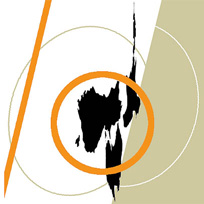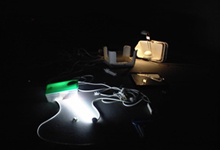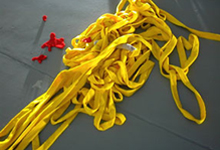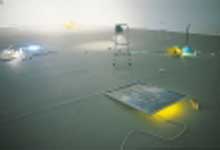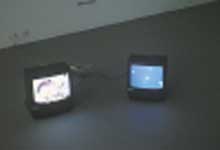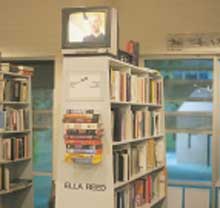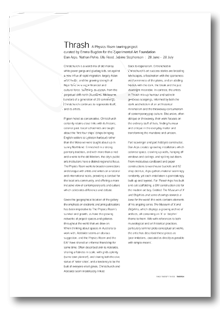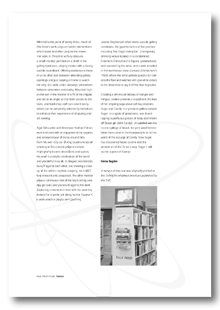 |
|||||||||
|
|
| ...GALLERY EXHIBITS 2001 | ...THRASH: Essay by Emma Bugden | |||||||||||||||||
|
Thrash Often described akin to Adelaide, sharing a flatness in scale, with grids aplenty, and sharing the civic status of ‘sister cities’, Christchurch is an uneasy mix of old money, white power gangs and gluebag kids, set against the new influx of rapid migration, largely from Asian and Pacific nations, and the growing strength of local iwi Ngai Tahu as a major financial and cultural force. Suffering, as have most South Island towns and cities, from the drift north (Auckland, Melbourne, London) of a generation of 20 something’s moving to bigger centres, Christchurch continues to regenerate itself, and its artists. Pigeon holed nationally as somewhat conservative, Christchurch certainly retains close links with its historic, colonial past. Enmeshed in a strong painterly tradition, and with more than a nod and a wink to the old Masters, the city’s public arts institutions have a distinct regionalist focus. In contrast, The Physics Room has endeavored to broaden connections and dialogue with artists and writers on a national and international scale, providing a conduit for the local arts community, and attempting to offer a more inclusive view of contemporary arts and culture which celebrates difference and debate. For the Physics Room, central to the gallery’s tenets has always been a focus on technology within contemporary arts practice, and a desire to expand the presentation of practice beyond the gallery, with parallel, integrated activities launched in the gallery, print, and electronic publications. Given the geographical location of the gallery the emphasis on electronic and print publications has been imperative to The Physics Room’s survival and growth, as have the growing networks of project spaces and galleries we link with throughout the world. As residents of sister cities Christchurch and Adelaide, and with regular informal contact, it seemed relevant (and necessary!) for The Physics Room and the Experimental Art Foundation to join forces in an exhibition exchange between the spaces. As electronic communication breaks down geographic and demographic borders, the relationship between centre and margin is increasingly blurred. Global interaction has become a valid option for New Zealand artists, from the formal interactions administered by our funding authorities, to small guerilla invasions from artist run spaces. The traditional cultural cringe, which saw New Zealand for so long locate itself as peripheral to some external centre, first England (‘home’ to colonial settlers) and Europe, later America and Asia, has began to be shaken off, and we are able to embrace our status as a Pacific nation, with increasing cultural diversity, and a shifting, changing population and art worlds. Entrenched in New Zealand’s, but most of all Christchurch’s, art success stories are brooding landscapes, a fascination with the sparseness and barrenness of the plains, and an abiding fixation with the dark, the bleak, and the just downright miserable. In contrast, the artists in Thrash mix up humor and satire in generous scoopings, informed by both the stark aestheticism of an art historical minimalism, and the throwaway consumerism of contemporary pop culture. Discursive, often oblique or throwaway, their work focus’s on the ordinary stuff of lives, finding humor and critique in the everyday matter and transforming the mundane and unseen. Part scavenger and part hobbyist constructor, Dan Arps creates sprawling installations which colonize space, crawling up walls, hanging off windows and ceilings, and spilling out doors. From meticulous cardboard and paper constructions to warehouse buckets and $2 shop detitrus, Arps gathers material seemingly randomly, yet each installation is painstakingly built up and layered. For Thrash Arps has built a kit-set scaffolding, a DIY construction site for the modern boy. Entitled The Museum of X and Dolphins and some drawings towards a base for the world, this work contains elements of his ongoing series The Museum of X and Dolphins, which displays a growing archive of artifacts, all containing an ‘X’ or ‘dolphin’ theme to them,. Rife with references to both museological and art historical practice, particulary seminal proto conceptual art works, the artist has described these pieces as ‘poor imitations...executed as directly as possible with simple means’. Serving the purpose of a museum display case, with objects hanging off or perched atop the structure, from small plastic key rings to a shiny blue waxy dolphin candle the museum offers a fetishistic collector’s approach to the objects which creates a context far beyond their initial production. Minimal to the point of barely there, much of Ella Reed's work plays on subtle interventions which tease and often perplex the viewer. In her Masters submission at Christchurch's Centre for Contemporary Art in 1999, Reed transformed the foyer of the gallery, stripping back the detailing and furnishings to render the foyer in the minimal white palette of the gallery itself. Dressing gallery staff for the occasion in (Dunedin designer) Blanchet black, and reducing and controlling the gallery environment, Reed's work served to frame and critique the work of fellow exhibiting students, the arts institution, and the gallery itself. Her work in Thrash is similarly obscure, a small monitor perched on the wall beside the entrance way, playing continuos TV with a barely audible soundtrack. Offering assistance to those of us so often torn between attending gallery openings and just staying at home to watch the telly, this work slides sideways somewhere between simulation and reality. Mounted high on the wall in the manner of a TV at the chippie, and near enough to the door to seduce the audience on their way out, this work, playing program after program, strikes one with it’s sense of familiarity of content, if not context. Yet, as a New Zealander based in Wellington, many of the programmes playing as part of Reed’s work are unknown and unseen by the artist herself. Ngai Tahu artist and filmmaker Nathan Pohio’s work is infused with an enjoyment of the vagaries and idiosyncrasies of those around him, from his own rally car driving cousins to social smoking in the current political climate. Highlighting bizarre obsessions and quests, his work is a playful celebration of the weird and wonderful in us all. In Sleeper, included in Thrash, two film production field monitors face off against each other, one showing a close-up of the artists nephew sleeping, his child’s face innocent and unexposed. On the other monitor plays the continuos shot of the boy’s ceiling view, day glo stars and planets lit against the dark. Each monitor sits inside a yellow plastic box from chain store The Warehouse (‘where everyone gets a bargain’), with one sitting on a folded, patterned blanket of Maori design. Referencing the artists background in film production, and capturing a moment in time with his unerring instinct for a gentle, yet biting humor Sleeper is a work which is both playful and touching. Julaine Stephenson’s art practice is infused with and defined by her dual roles as artist and project co-ordinator, incorporating installation and site specific work in public sites, most notably as organizer of a large-scale multi-media project throughout the tiny township of Otira. Often working outside gallery constrains, the guerilla tactics of her practice include ‘the illegal roving bar’, a temporary drinking venue located in a condemned Cinema in Christchurch’s Square, presided over, and operated by the artist. Themes of celebration, luck, and anticipation run throughout her work, ranging from the ever present danger of living on a faultline, to the infinite possibility of winning the lottery. Creating a whimsical tableau of danger and intrigue, for Thrash Julaine presents a snapshot of her larger-than-life, soft toy creations Sugar and Candy. In an earlier episode at Christchurch’s public art space the Kiosk, Sugar, in a spate of greediness, was found ripping superfluous pieces of body adornment off Skater girl (AKA Candy). Unsatisfied with the recent spillage of blood, the pint sized femme fatale then called in the heavyweights to rid her world of the scourge of Candy. Now Sugar has discovered haute cuisine and the ancient art of the Ta-ke-a-way. Sugar's still out for a piece of Candy! Emma Bugden View Thrash - curated by Emma Bugden for the Experimental Art Foundation - Essay by Emma Bugden as a PDF This essay also appeared in The Physics Room
Annual 2001
|
|||||||||||||||||
